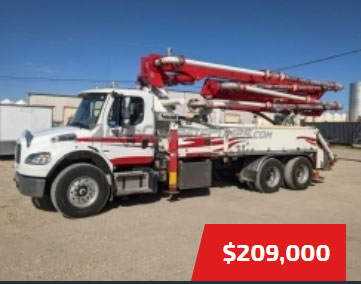| Derputzmeister | 05-16-2007 | comment profile send pm notify |
|
Preferred Concrete Greenville Calif http://s148.photobucket.com/albums/s39/mattandveca/?action=view¤t=boomvideo2-1.flv Dewitt Construction Quincy Calif http://s148.photobucket.com/albums/s39/mattandveca/?action=view¤t=DewittConstVideo.flv Pyramid Builders Portola Calif http://s148.photobucket.com/albums/s39/mattandveca/?action=view¤t=boomvideo.flv
|
||
| Todd | 05-16-2007 | reply profile send pm notify |
|
Wow Pyramid Builders Portola Calif is going to kill someone someday using that s pipe. That video will be used against them in court someday as proof that they dont care about the life of the hose man. |
||
| Derputzmeister | 05-16-2007 | reply profile send pm notify |
|
I know, they are big concrete purchasers....and they demand using it....one day the boss wasn't there for one of their pours, we just used a straight 4" hose, the crew loved it, but the boss came back and wants the velocity reducer. I hate that metal dangling at the end of the hose.... |
||
| Todd | 05-16-2007 | reply profile send pm notify |
|
Well it will be the pump owner who has to pay for the damage. Just because somebody wants you to do something wrong does not mean you do it. My brother who is a paramedic always says that your blood and guts is his bread and butter. Some lawyer will love to get a hold of that video. Just wait and see no expert witness will defend that practice. The ACPA and everyone will come to the aid of the defendant just wait and see. S tubes kill and should be outlawed. I am not trying to be a hard ass I am just trying to save somebody’s life and the life of the company that is using it. |
||
| eugene | 05-16-2007 | reply profile send pm notify |
|
pretty cool vidio work i thought the first guy was stud, the second guy was a slip away from that up right rebar and the last shot with a crew working with out safety caps on the bar as well thats the most common injury i deal with. even some tie wires have got me a good one.
|
||
| brandon | 05-17-2007 | reply profile send pm notify |
|
WOW WONDER IF THAT COMPANY IS IN N.C. I'LL HAVE TO KEEP AN EYE ON THE NEWS. NO FOREMAN IS GOING TO CAUSE ME TO BE THE GUY THAT CAUSED DADDY NOT TO COME HOME, AND MY COMPANY WOULD STAND BEHIND ME 100%. TO WORDS (REDUCING HOSE) JUST AS SMOOTH AFTER A LITTLE TWEAKING. |
||
| brandon | 05-17-2007 | reply profile send pm notify |
|
GREAT VID THOUGH ;) |
||
| Todd | 05-17-2007 | reply profile send pm notify |
|
This is a better and safer way to go. Check out this hose. http://www.constructionforms.com/pdf/newspumper/NewsPumper9-03.pdf |
||
| Todd | 05-17-2007 | reply profile send pm notify |
|
I just got off the phone with a big wig who is part of the ACPA and they say that you should not use the S Tubes. They are really really dangerous and they will not even use a picture of one in the magazine. If everyone is using them we should figure out a way to not use them. |
||
| brandon | 05-17-2007 | reply profile send pm notify |
|
THAT IS WHAT I USE A 5 TO 4 RUFFNECK FOR THE LARGER SLABS AND FOOTINGS AND A 5 TO 3 FOR BLOCKFILL AND ICF WALLS. WORKS GREAT |
||
| MidnightRider | 05-18-2007 | reply profile send pm notify |
|
Well he wont buy anymore when he eats that Stube , i mean literally. The company who bought us out several years ago used them then one day they were told thats it no more, people get adjusted once you tell them that OSHA outlawed them, or any other metal end as far as that goes, they will learn to like a 4" hose just as much or eathier a tapered. |
||
| Bob | 05-18-2007 | reply profile send pm notify |
|
The fact of the matter is that there are NO OSHA RULES preventing the use of "S" tubes....... we used to call them 'velocity reducers'. What should keep you from using them, or any hose with any kind of fitting or device is the fact that the ACPA has officially come out against them; AND they ae a 19th century fix for a 21st century problem. Ask your insurance company. And by the way, if your insurance company does not know what you are talking about, you probably have the wrong insurance carrier. |
||
| 40667 | 05-18-2007 | reply profile send pm notify |
|
Does someone have some stats on how many people have been killed or hurt by velocity reducers or metal ends on hoses? How are they killed or hurt, hose whip or operator hitting them with it. Has anyone done any tests to show that a hose whip intensity is more or less with a velocity reducer? I think these questions should be answered before anything is outlawed or for that matter deemed unsafe. I personal do not like that big hunk of iron hanging on the end of the hose but I also do not like seeing those icf forms exploding either. |
||
| Derputzmeister | 05-19-2007 | reply profile send pm notify |
|
Here is a vid of a 5 to 3" reducer coupled to a three inch hose, (the hose could be shorter), I have a putzmeister pour pin on the end of the hose also.....the pour pin work fairly well with the 3" hose, however, they wear fast and cost about $115.00, so I save it for speed block and ICF only. Hard to tell exactly by the vid, but there was no mess. Pumping at the lowest volume and very low RPMs, 6sx 3/8 pea, 6 inch slump. Video taken 18 May 07. http://s148.photobucket.com/albums/s39/mattandveca/?action=view¤t=dewittconstuction.flv |
||
| MidnightRider | 05-19-2007 | reply profile send pm notify |
|
here is an example. Salamanca v. CF&T Available Concrete Pumping This case involved an industrial accident that occurred at the Bechtel Power Plant in Costa Contra County. Plaintiff Salamanca was a 52-year old laborer who had immigrated to the United States as a teenager. Plaintiff was in a large ditch acting as a hose man for a concrete pump truck that was filling a ditch with a slurry mix in order to protect pipelines for the power plant. Mr. Salamanca noticed a clog in the delivery line while he was holding onto the hose. He advised the pump operator to turn off the pump and return to the hopper and clear the clog. Mr. Salamanca continued to hold onto the end of the hose, and when the pump was turned back on, the clog broke loose causing the hose to whip violently and strike Mr. Salamanca. Plaintiff sustained a torn rotator cuff and underwent surgery. Plaintiff incurred $29,000 in medical expenses and returned to work in a different capacity other than construction within one year. However, Plaintiff's physician recommended he not return to concrete construction due to his injury. Defendant argued that the accident was Plaintiff's fault for holding onto the end of the hose knowing that when the pump was turned back on, it had the potential to whip violently. Defendant also argued that even if Mr. Salamanca could not return to work, his work life expectancy in the concrete trades could only have been three or four more years since he was already in his 50's. Pre-Trial offer by the defense was $100,000. Plaintiff offered to settle the case via C.C.P. Section 998 for $400,000. Verdict: $650,000. After the verdict, Defendants had to pay costs and interest which brought the total judgment to over $700,000. Bet he dint have an Stube or that guy would be dead and the settlement would have been in the millions. Injury Type : Fractured foot
|
||
| 40667 | 05-19-2007 | reply profile send pm notify |
|
Thank you Midnightrider for the examples. But it sounds like, from these 2 examples tip hoses should be outlawed or deemed unsafe and of course if that is done we will not have to worry about velocity reducers or steel ends. |
||
| Bob | 08-20-2008 | reply profile send pm notify |
|
I saw this in the antique post zone. It seems as if we now have more of a consensus as to the unsuitability of any device on the discharge end of the placing line. This is a very good thing. We seem to be making some headway in this area of pump safety. The one type of pour that is still a problem is ICF work. Even though the much slower pour rate on ICF walls reduces the potential of a hose whipping incident it does not entirely eliminate it. Homemade or stopgap measures to force the concrete to flow smoothly into the wall are usually not thought all the way through. Adding mass to the discharge end of the hose is always a mistake. It is your job as the pumper to educate your customer as to the danger. Many times the customer will want to stop the pour to let the prior lift to begin to set. Make sure that when you start pumping after these delays that you do it away from your co-workers. This is the time of maximum danger. Forewarned is usually forearmed. If is not, don’t let yourself be bullied into a dangerous situation. Both you and your insurance company will be glad that you stood your ground. It is your job to do it right. For safety’s sake. |
||




















.jpg)
.gif)

.jpg)









.jpg)








